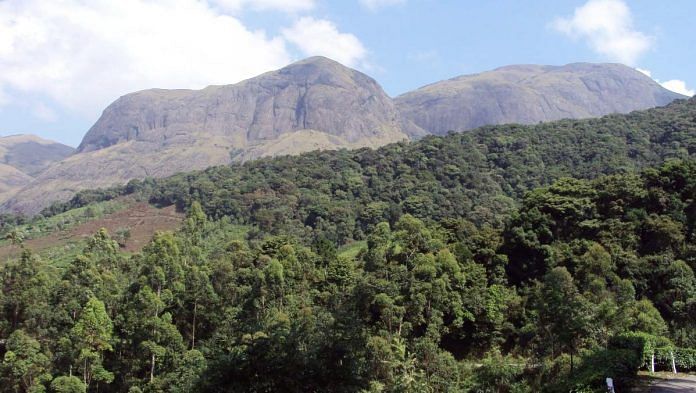Bengaluru: A new study by researchers at the Indian Institute of Science (IISc) in Bengaluru has found that the biodiversity-rich Western Ghats will lose its capacity to absorb about 7.5 per cent of India’s annual carbon dioxide (CO2) emissions over the next decade.
India produces around 3.1 million gigagrams (MGg) of CO2 each year.
The paper titled ‘Carbon Sequestration Potential of the Forest Ecosystems in the Western Ghats, a Global Biodiversity Hotspot‘ was published last month. The study notes that monoculture plantation, agricultural expansion and other developmental activities like mining and hydroelectric projects will result in erosion of 0.23 MGg of carbon sink capacity of the Western Ghats between 2018 and 2031.
Forest ecosystems are important for the survival of humans because they are massive carbon sinks. This means forests absorb CO2 from the atmosphere and store it in wood, below-the-ground biomass like the root system and in the soil. This process of CO2 absorption and storage is called carbon sequestration.
But land use and land cover changes like clearing of forests for plantations, agriculture and mining, etc in the Western Ghats are threatening this process of carbon sequestration, the paper notes.
Forests are considered as ‘water towers’ because they contain many springs and streams that are the sources of major rivers. The rivers flowing from the Western Ghats supply water to most of peninsular India and irrigate about 10 million hectares of agricultural land. This is also how the Western Ghats ensure food and water security to over 245 million people in South India.
T.V. Ramachandra, coordinator of the Energy and Wetlands Research Group at IISc and one of the authors of the study, explained how catchment areas – from which rainfall flows into a river, lake or reservoir – have high water retention capability.
“When there is vegetation, water percolates into the ground. Because of this, water is available in the streams post monsoon too. Without this, rain water would flow into the oceans,” the scientist said.
Ramachandra and his team observed that in places where native trees and grasses were present in the Western Ghats, the streams had water throughout the year. But in areas covered by monoculture plantations, water flowed for about six-eight months only. And in cases where catchment areas were completely degraded, streams had water only for three-four months during monsoon.
Also read: Aarey, smog, wildfires — forests dominate headlines. But what exactly is a forest?
Forest cover reduced by 5% in 40 years
Around 18 per cent of the Western Ghats is under plantation, 38 per cent used for agriculture and another five per cent for mining and other developmental activities.
The forest cover in this mountainous stretch has reduced by five per cent in the past 40 years due to increase in agriculture, plantations and other developmental activities, the paper states.
Areca nut, coconut, coffee, tea, rubber, spices, paddy, sugarcane, cereals and cotton are some of the major products grown commercially in the Western Ghats which also has massive hydroelectric projects and industries.
It also notes that part of the mountain range in Goa has lost “large tracts of interior forest cover due to the indiscriminate rampant mining activities” while in eastern Kerala, Tamil Nadu and Maharashtra agriculture and developmental activities have taken a toll.
Deforestation and change in land use have also contributed to an increase in average temperatures in the Western Ghats by about 0.5 degrees Celsius. The number of rainy days have also reduced, meaning the same amount of rainfall is getting concentrated in less number of days.
Also read: How a tiger is poached in India in 2019: Breaking down the supply chain
Impact on farmers
Ramachandra said hydrological consequences of monoculture plantations in the Western Ghats have severely impacted the livelihood of farmers.
“Farmers in the vicinity of forests usually earn about Rs 1.5 lakh per acre every year and those practicing agriculture in the vicinity of monoculture plantations earn about Rs 32,000 per acre each year,” he said.
The difference in incomes, he explained, was due to low productivity because of water shortage in areas closer to monoculture plantations and the lack of pollinators like bees and birds in these places due of excessive insecticide use.
He added that agricultural practices are sustainable only in a smaller scale and via multiple cropping practices.
There are 4,600 species of flowering plants (38 per cent endemic), 330 butterflies (11 per cent endemic), 156 reptiles (62 per cent endemic), 508 birds (4 per cent endemic), 120 mammals (12 per cent endemic), 289 fishes (41 per cent endemic) and 135 amphibians (75 per cent endemic) in the Western Ghats, one of the 36 global biodiversity hot-spots.
“Biodiversity also has direct benefits to people because it provides food and medicine. By degrading the forests we are losing carbon sink capacity, enabling climate change and losing biodiversity,” said Ramachandra.
Also read: English-medium schools, cars, Europe markets: How this tribe became richest in Western Ghats



